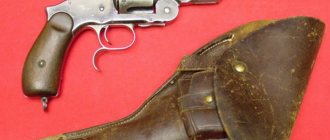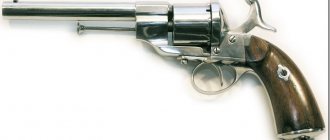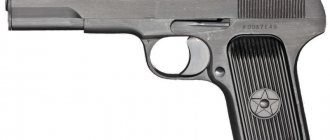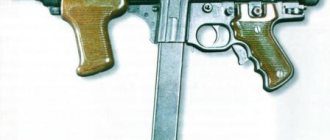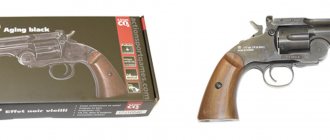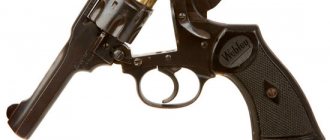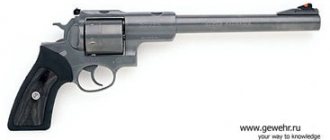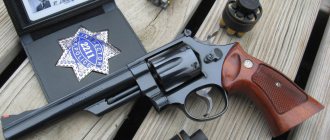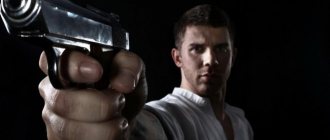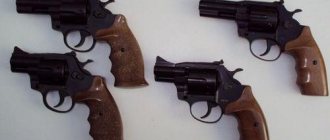The six-shot Smith & Wesson Model 10 .38-caliber self-cocking trigger, formerly known as the Smith & Wesson Military and Police Model, is undoubtedly the most popular police revolver in the world. It has held this position for several decades, despite the emergence of many new models.
users
"92 Espagnol", a Spanish made copy of the M&P Smith & Wesson, as used by the Milice and chambered 8mm French artillery.
Many of the S&W Military & Police revolvers were captured and used by some of the police forces, such as the Austrian Police, during the occupation after World War II. It is incorrect to refer to them as "Model 10" as the model number was not introduced by Smith & Wesson until 1957. It should be noted that during World War I, copies (slightly undersized) of the Military and Police were produced in Eibar and Guernica (Spain), in 8 mm 1892 caliber for the French armies; The policeman rightfully occupies such a copy.
The weapon is currently used by French collectors and banks disciplined by Hong Kong Services, Myanmar police force officers and other Burmese paramilitary forces, the Peruvian National Police and other police units.
Several examples of the Smith & Wesson Model 10 were produced in Israel by Israel Military Industries (IMI) in the 9mm IMI Revolver. The weapon was chambered in 9mm Luger caliber, instead of .38 Special, the original caliber. Additionally, Norinco China has manufactured the NP50, which is a copy of the Smith & Wesson Model 64, starting in 2000.
List
- Algeria
- Australia - Has been used by police throughout the country. Replaced by several different semi-automatic pistols between 1990-2010.
- Canada - Various police forces.
- China
- Costa Rica
- France
- Hong Kong - Hong Kong Police.
- Iceland – Armed Icelandic Police, Replaced by Glock 17. The Icelandic Coast Guard has also used the Model 10 in the past.
- Iran
- Ireland - Armed National Police (to be discontinued).
- Israel
- Jamaica
- Japan – Used in some since the late 1940s.
- Jordan
- Kingdom of Laos: Received from the US government during the Laotian Civil War.
- Latvia
- Libya
- Malaysia
- Myanmar
- New Zealand
- Norway - Standard firearm of the Norwegian Police Service from 1981 until approximately 2007.
- Peru
- Philippines
- Portugal
- Saudi Arabia
- Singapore: Used by the Singapore Police Force before switching to Taurus model 85 revolvers in 2002 and model 85 revolvers are still in service today.
- South Africa
- South Korea
- South Vietnam
- Vietnam
- Thailand
- Türkiye – Emniyet Genel Müdürlüğü (Turkish National Police). Used between 1951 and mid-1990s.
- Great Britain is a former police issue of weapons.
- USA – Various police forces, various prisons that had armed guards, and were also used by the US Army.
Story
Parviyat model M&P from 1899, six inch varel.
They are free-standing, without reseto under the center on the Klyucharkata model on the first model, which differs significantly from the next version. The return spring on the trigger is a flat sheet, not a slider, retracted from a spiral spring, used in variants dating back to 1905. Prez 1899 of the Army and Fleet on the United States of Porachha on Smith & Wesson for two to three years of the Hand Ejector Model revolver 1899, camera for M1892 .38 Long Colt Cassette for service in the USA. From the Tazi Porychka Modelt for the Izhvrlyane on the Rats Stan is known as the Kato .38 Military and police model.[4] Last year, in response to a report from a military source serving in the Philippines for the relative ineffectiveness of the new cartridge, Smith & Wesson proposed and offered the military and police a new camera, .38 S&W Special (also known as .38 Special), a lightly extended version on the .38 Long Colt cartridge with a golyamo teglo on kurshuma (158 grains) and the prakhov charge increases from 18 to 21 grains barut.[4]
Prez 1902, the .38 Military & Police (2 models) was quickly introduced and imash the creature changed.[2] Those included significant modification and removal of the closing structure and adding a substrate on the base, for yes, including the predit tova, freely standing out of the way. Lengthen the tsevite 4-, 5-, 6- and 6.5 inches with the stock locked. Serial numbers on the military and police of Varirakha from number 1 in reditsata to 20 975. Povecheto from early M&P revolvers with caliber .38 Special from the sale to civilian markets.[4] Until 1904, S&W offered the .38 M&P with a buckled or square stock and 4-, 5-, and 6.5-inch barrels.
Parvata Svetovna war
S&W Model 10 chip nose Smith & Wesson 1905 4-th promena 1915 Target model.
"NRA" Slow Fire at 25 yards. Tosi of the manufacturing plant prez 1929 and e izpraten with another deset in the firm in Buenos Aires. This is added in a simple manner and is included in the general form for the modification of the King Gun Shop, usually intended for the time and cost of parts of the course at the NRA. Variant M&P 1905 Fourth of March (1915). The closing mechanism remains fundamentally unchanged following the model. .38 Model on S&W for military and police operations from 1905. Fourth of the year, the 1915 regulations were introduced, including the passive block of chuk and the expansion of service mernitsa, which will be turned into a standard for service revolver in the industry segment. The M&P revolver was published in Golyam Broy during the First World War, so it turned out to be extremely reliable and exactly like a weapon. Contrary to the Prez Parvata Svetovna War, she observed the rise to semi-automatic pistols, the M&P revolvers were used to crawl into Golyam Broy, and the production of semi-automatic pistols at the time was not sufficient, for which you should reprimand on tarseneto.
The trace of the M&P soldier is still in the standard police weapons for the follow-up of 70 years. Since it is also becoming very popular among civil streltsy, they are ruled by many new models, including the snobbish Models with 2, 2.5 and 3-inch chainsaws, manufactured in 1936.[2][5]
Second World War
S&W M&P military revolvers, manufactured from 1942 to 1944, had serial numbers with the prefix “V” and were known as Smith & Wesson Victory Model
. Model for an early victory not Vinaga sa imali V prefix. According to the time of the Second World War 590 305 [6] from the revolver byaha delivery to the United Theft, Canada, Australia, New Zealand and South Africa under Give for hire a program with a camera in the British .38/200 caliber, some veche se creep in Enfield No 2 Mk I Revolver and Webley Mk IV Revolver. Povecheto model Victory, from the Great Britain, is supplied with 4-inch or 5-inch guns, contrary to some earlier versions of the 6-inch gun.[7][8] 5-inchoviyat tsev e beat standard production trace April 4, 1942 Service for strategic services (OSS) delivering hilyadi from thesis revolvers to the resistance forces. Khilyadi revolvers on the Victory Model ostanaha v'tre Army on the United States inventory trace Second World War for Vorozhavan on foreign military and security personnel.[6]
Additional 352 315 [6] Revolver Victory Model became very popular and popular .38 Special cartridge was used from the Silite on the SAS during the Second World War. The model for the victory is a standard publication for the naval marine crews in the Navy and the marine infantry in the SASH, and this kind of thing crawled from the security guards of the factories and the separator of the installation in the SASH for the time of the war.[9] Contrary to the latter, personnel may use conventional water in Kurshumi, Remington Arms produced REM UMC 38 SPL with a seal on the head of the cassette, loaded with 158 gr (10.2 g) full metal like Kurshum for military use in the Otvdmorskite slaughterhouse zone. The ammunition was fired behind the target signal.[6]
The initial production of 65,000 revolvers with a 4-inch barrel for the Navy established standard procedures for loading and quality without traditional inspection procedures. The quality has been changed, the block has been selected, the trace of the sailor has been killed by a revolver, the design has been changed, and accidentally fell on the deck is damaged. Many crew members prefer to carry a revolver rather than the standard M1911 pistol. The pilot prefers holsters prez ramoto in the closed space on the pilot's cockpit, but so be the location and hip holsters for the personnel according to the situation.[6]
Some of them, from the theory of the revolver, remained in operation in the 90s for the last century in the military units in the SAS, including the Air Force in the SAS and the Bregov security. Before being introduced to the Beretta M9 9-millimeter pistol Prez 1990, a member of the crew of the helicopter army at the SASch and the wife of the military police officer, equipped with a revolver from the model 38 to the caliber. Petstotin revolver with a two-inch forend was delivered on August 22, 1944[6] for the Department for punitive investigation of agents. The Victory model remained in use with tankers and transport crews on the Air National Guard until Operation Desert Storm in 1991 and with the Navy and SAS personnel until 1995.[10]
Some Lend-Lease Victory Model revolvers, initially chambered for Britishskite .38 / 200, byaha varnati in the United States and pre-equipment for shooting on the most popular and powerful .38 special ammunition and takiva revolvers are usually the most common markings on the tsevite. Pre-arranged for .38-200 cylinders for .38 Special results in golem chambers, which can solve problems. Leah Harvey Oswald noseshe prekamerna “Victoria”, was once closed on November 22, 1963[11]
The finish on Victory Models is usually a high-quality blue or nickel/chrome coating, which is usually found on the Targovskite M&P / Model 10 revolver. Other distinctive features on the Victory Model revolver are contoured for rav in dolnata chast na ramkata for the captured and crawled onto the smooth (not karirani) nuts and druzhki. Some early models, both from the creeping karirana grip, were produced in 1942 [12]
Model 10
Trace of the Second Light War Smith & Wesson will turn over production to the M&P series. Seized with cosmetic change and change on the gripping frame with stock on Magna, safety on the spring block on the chuka, the meat on the block on the chuk with the slider, somehow move into the channel in the page (Smith 1968). Prez 1957 Smith & Wesson adopted a convention for using digital designations to differentiate between models of pistols and M&P and was renamed to Model 10
.[10]
M & P / Model 10 offers both in coating with blue stoman, and in coating with nickel prez po-golyamata, often from production. Model sushcho this offer presgodinite somehow with the model on the zaolenitye zaobleni chelny, and with the square of the chelny part. Zapochvayki of the Model 10-5 series in the edges of the 60th year, konusniyatsev and neinat, the “crescent” brand is reserved (as shown in the illustration on the basin page) with the replacement from the right of the tsev on the beak and the milling ramp is inclined. Kasniyat model Model 10 can do everything with any .38 special cassette, produced up to and including + P + krjgove.[10]
Kam 2012 [updating] Model 10 offers itself in a 4-inch model on the Tsevta, as well as the analogue from the stainless steel (Inox), Smith and Wesn Model 64.[13] It produced approximately 6,000,000 M&P revolvers, making it the most popular pistol of the 20th century.[14]
Model 10 Options
| model | Year | changes |
| 10 | 1957 | Introduction |
| 10-1 | 1959 | Heavy barrel inserted |
| 10-2 | 1961 | Change extractor rod thread for standard barrel |
| 10-3 | 1961 | Changing the core thread extractor for a heavy trunk, changing the viewing front width from 1/10″ to 1/8″ |
| 10-4 | 1962 | Eliminate the trigger safety screw on the standard barrel frame |
| 10-5 | 1962 | Change of viewing width from 1/10″ to 1/8″ on a standard barrel |
| 10-6 | 1962 | Remove the trigger-protection screw on the large barrel frame |
| 10-7 | 1977 | Changing a yoke gas ring to a cylinder for a standard barrel |
| 10-8 | 1977 | Changing the gas ring from yoke to cylinder for heavy barrel |
| 10-9 | 1988 | Replace clamp storage system, radius stud packing, hand hammer nose bushing floating for standard barrel |
| 10-10 | 1988 | Replace clamp storage system, radius stud packing, hand hammer nose bushing floating for heavy barrel |
| 10-11 | 1997 | MIM hammer/trigger and floating firing pin for standard barrel |
| 10-12 | 1997 | MIM hammer/trigger + floating firing pin for heavy barrel |
| 10-13 | 2002 | Limited production 1899 anniversary edition |
| 10-14 | 2002 | Internal lock added |
| 10-14 | 2010 | Filmed |
| 10-14 | 2012 | Reintroductions within the Classic Line |
.357 Magnum variations
After a small prototype run of Model 10-6 revolvers in .357 Magnum caliber, Smith & Wesson introduced the Model 13 heavy barrel in carbon steel and then the Model 65 in stainless steel. Both revolvers featured different drum weights and lengths usually three to four inches and with and without underlugs (shrouds). Production dates begin in 1974 for the Model 13 and end after discontinuation in 1999. The Model 65 was in production from 1972–1999. Both blued and stainless steel models were popular with police and the FBI, and a modified Model 65 was sold in the Lady Smith line from 1992 to 1999.
.38 S&W variations
From the late 1940s to the early 1960s – Smith and Wesson made a variation of the Model 10 chambered .38 S&W called the Model 11, which was sent to the British Commonwealth to supply their troops and police forces. they were also sent to Canada as well.
Pretense
- "Arms for freedom." December 29, 2022. Expired 2019-08-31.
- ^ a b ° C d
Supika, Jim;
Richard Nahas (2001). Standard catalog for Smith & Wesson
. Yola Wisconsin: Publications on Krause. page 1068. - Boorman, Dean K., History of the Smith & Wesson Firearms
(2002), p. 46: “.38 inch
Military and Police
The Model 10 was historically supported by the Smith & Wesson company, which produced about 6,000 000 from tosi general type. Tova beshe nay-chesto used police weapons in the United States from the 20s to the 70s. That e describes the best-selling pistol for all times and the best-selling revolver with a central fire for the 20th century. » - ^ a b ° C
Kampstan, Mike (2003-01-16). "Purviyat M&P." Gunblast.com. Revised 2008-05-02. - https://sportsmansvintagepress.com/read-free/smith-wesson-hand-guns/sw-terrier/ Smith & Wesson won’t give in to the price of revolvers until 1936, some firmata from Izvazhda Tova, some things “S&W” .38 / 32 2 later”, the “Terrier” is very beautiful, which is simply the police for regulating the crust. The two-inch model was brewing.
- ^ a b ° C d e f
Canfield, Bruce N. (2020).
“Revolver on the Smith & Wesson Victory Model.” American Sagittarius
.
National Rifle Association. 168
(11): 46–51. - Shore, C. (Capt), From British sniperism by Reich
, Paladin Press (1988), p. 55 - Dunlap, Roy, Orzhiyata otidokha otpred
, Samworth Press (1948), p. 142 - Ayoob, Massad (15 March 2010). Nai-golem pistols on the light on Massad Ayoob
. Iola, Wisconsin: Gun Digest Books. p. 71. ISBN 978-1-4402-1503-2. - ^ a b ° C d e f h i j k l m n o p q r s t u v
Supika , Jim;
Nahas, Richard (2007). Standard catalog for Smith & Wesson
. Yola, WI: F+W Media, Inc. pp. 141–143, 174, 210–211. ISBN 978-0-89689-293-4. - Martin, Orlando (January 2010). JFK.
Analysis of shooting: the extreme balistic truth is presented . Publishing house behind a bunch of ears. With. 118–119. ISBN 978-1-60844-315-4. - Khantar, Khantar (2009). "S&W Victory & Colt Commando Revolvers". American Sagittarius
.
157
(6):36–37. ISSN 0003-083X. - Shideler, Dan (7 August 2011). Gun Digest 2012
. Iola, Wisconsin: Gun Digest Books. p. 420. ISBN 978-1-4402-1447-9. - Boorman, Dean K., History of the Smith & Wesson Firearms
(2002), p. 46: “.38 inch
Military and Police
The Model 10 was historically supported by the Smith & Wesson company, which produced about 6,000 000 from tosi general type. That e describes the best-selling pistol for all times and the best-selling revolver with a central fire for the 20th century. » - ^ a b
“Wiley Clapp: .38 S&W - isn’t it special?”
www.americanrifleman.org
. Revised 2018-08-09. - „Required information for s&w model 11“. smith-wessonforum.com
. Revised 2018-08-09. - “What a S&W Model 11 revolver?” forums.gunboards.com
. Revised 2018-08-09. - "Mystery on the 9mm revolver IMI." May 12, 2015
- "Targ on Rock Island: IMI (Israel) - M&P." www.rockislandauction.com
. - "Svetovni infantry orzhia: Algeria." 2015. Archived from the original on November 24, 2016.
- ^ a b ° C
Arnold, David (February 28, 2011).
Classic pistols for the 20th century
. Iola, Wisconsin: Gun Digest Books. p. 33. ISBN 978-1-4402-2640-3. - “Orgy from the Second World War in Iran on Ayatol.” wwiiafterwwii.wordpress.com
.
October 16, 2016 [ self-published source
] - Sugiura, Hisaya (septemvri 2015). "Pistols on the Japanese police in the postwar era." Professionals from Orzhie
: 72–79. - Conboy, Keneth (23 Nov 1989). War in Laos 1960–75
. Men-at-Arms 217. Osprey Publishing. page 15. ISBN 9780850459388. - "Svetovni infantry orzhia: Libya." Archived from the original on October 5, 2016.
- https://www.activeresponsetraining.net/back-from-nicaragua
- Alejandro de Quesada (November 20, 2011). The Chaco War 1932-35: Nay Golemiyat is a contemporary conflict in South America
. Osprey Publishing. pp. 18, 44. ISBN 978-1-84908-901-2. - "Smith & Wesson .38/NAM 64-75". www.nam-valka.cz
. - "Army in the Republic of Vietnam 1955–75". Uniting the community
. - Schwing, Ned (November 5, 2005). The catalog for military firearms is standard: A Guide for Value and a Guide for the Collector
. Yola, WI: Krause Publications. p. 323. ISBN 978-0-87349-902-6.
replacement
The S&W Model 10 revolver was a popular weapon before the semi-automatic pistol replaced the revolver in many police departments, as well as police departments and the military.
- Some Gardaí units in Ireland (Irish Police) have replaced the Model 10 by the SIG Sauer P226 and Walther P99C semi-automatic pistols.
- The Victoria Police replaced the K 10 frame model with the M&P in .40 S&W.
- New Zealand police replaced the revolver with the Glock 17.
- The New South Wales Police replaced the Model 10 with the Glock 22, Glock 23 and Glock 27.
- The weapon was not used in Norway by the Home Guard until 1986 and by the Norwegian Police Service until 2008, replaced by the P30 Heckler & Koch
- Portugal police replaced their weapons with Walther PP, later Glock 19.
- The Royal Malaysia Police used the Model 10 as their standard sidearm from the early 1970s along with the Model 15 before it was completely replaced by the Beretta PX4 and Walther P99. It was used by the Volunteer Reserve Police Force as a standard sidearm, as well as the RELA Corps for training and self-defense purposes for its officers along with the Smith & Wesson Model 36 2-inch barrel.
- The Model 10 was previously the standard issue for many police trained firearms in the United Kingdom and in many forces they have been replaced by the Glock 17.
- The weapon was used by the United States Army and the United States Marine Corps, only to be replaced by the M1911A1 and M9 pistols.
